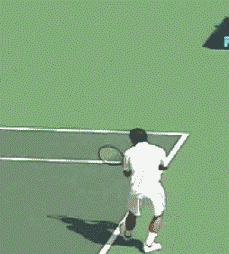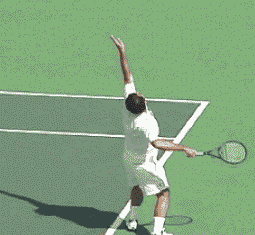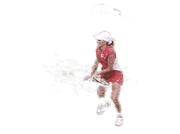Advanced Tennis: Sampras Serve
The Tossing Motion
John Yandell
Page 3
Spin on the Toss
As we have seen, spin is a critical factor in Sampras' serve - one factor that sets him apart quantitatively from the other top players.
Spin is also critical on the toss - or rather the complete absence of spin. As the ball floats out of Pete's hand, it literally hangs in the air, a knuckleball with no visible spin. If you have the good fortune to see him play at close range, you can see the seams and read the number while the ball is in the air - at least until the racket head shows up and delivers that searing, heavy rotation that sets Pete apart.
His release is so simple and soft that he imparts no spin whatsoever to the ball during the toss. This is a key factor is his tossing consistency. Players with erratic tosses frequently impart significant rotation to the ball, flipping it into the air with their fingers or wrists. This introduces another unnecessary variable that becomes difficult to control under pressure. Pete stays very relaxed and delivers the ball consistently to the same spot time after time. This relaxation on his tossing motion helps the rest of the motion stay relaxed as well.

Height of Toss
Watch closely on TV and you'll see clearly that Pete's toss drops from its apex about 12 to 14 inches before contact. How much drop is right for you? That you will need to feel for yourself. You should be able to move through the core positions at a smooth, relaxed pace without tensing, letting the racket acceleration build naturally. Your drop and extension need to be full. On the other hand, you should not feel any major pauses or hitches during the motion.
Start by tossing the ball 1 or 2 feet above your contact point and see how it feels. You'll definitely want to see your motion on video to make sure your racket is really falling all the way down and you are extended at contact. If you look tight or your drop or contact point aren't full, keep experimenting, moving the height of the ball upward until you find a rhythm that feels good to you!
The Opposite Arm After the Toss
Another controversial issue about the serve is what happens to the tossing arm after the toss? Some teaching pros argue the arm should be consciously pulled down hard and fast as if you were closely a window shade. Another theory that has gained great credibility is that the opposite arm should be pulled into the torso, serving as a "brake" that stops the body rotation and accelerates the arm.

If you observe Sampras's upper arm neither of these assertions appear to be true. After it reaches its extended position, the racket arm does come down, but it stays in line with the shoulder. The torso movement brings it down naturally - there is no independent pulling movement. Similarly, although the opposite arm folds in toward the torso, it never really stops moving. Rather than staying in close to the body and "braking" the torso, it continues to move to the left across the players body and then somewhat backward finishing completely clear and to the side of the body.
Far from "braking," Pete's torso continues to rotate through the contact point all the way to the finish. This continued rotation is actually one of the critical advanced elements in his serving effectiveness and the generation of such high levels of speed and spin, something we'll examine later in this series.
In point of fact, the deliberate work of the tossing arm ends at the completion of the extension. After holding the arm up for this brief interval, the player's focus should shift to bringing the racket head through the motion. The tossing arm simply relaxes and reacts, responding to the motion of the racket going to the ball by falling and flowing down and across.
What does this mean for the average player? Develop the straight down, straight up arm motion, the soft, no spin release, and the extension of the arm at the completion of the toss, and then forget about it! Let the arm relax while you key on the contact and finish. It'll take care of itself and move perfectly through the rest of the motion.




